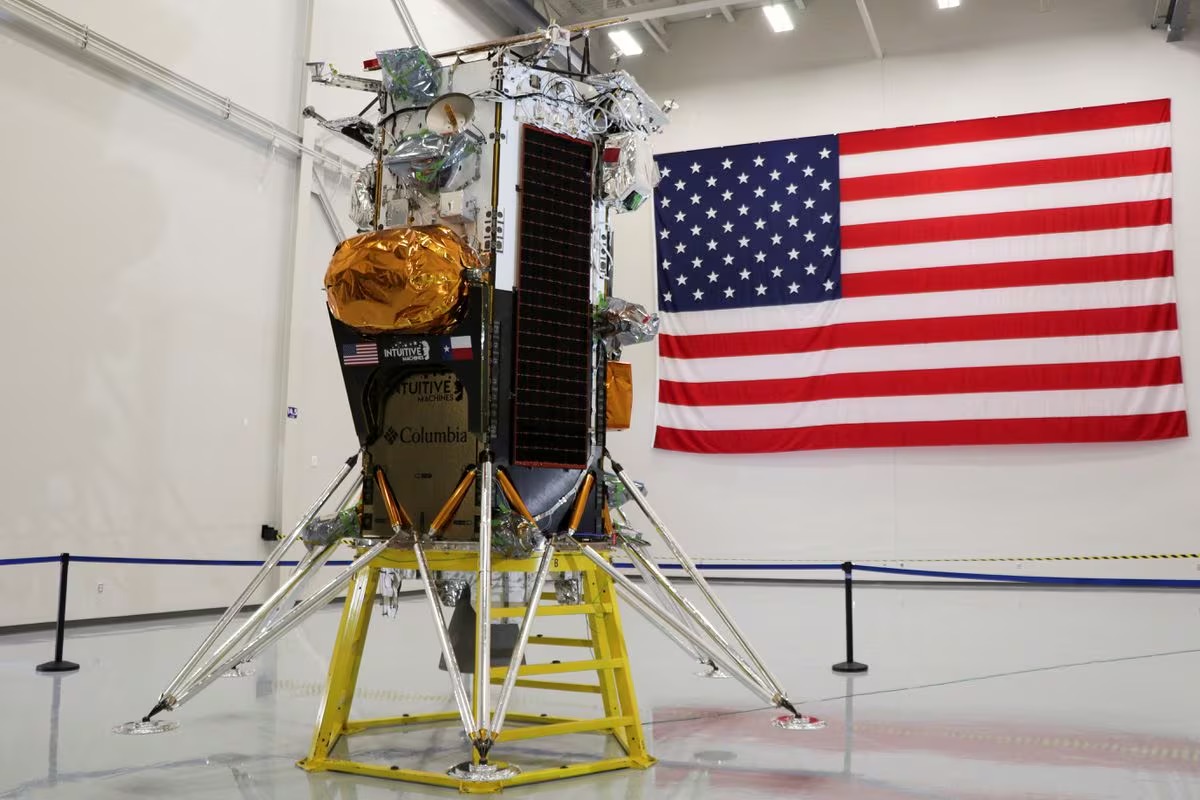
The launch of private US moon landing mission had been cancelled and delayed for a day due to abnormal methane temperatures before loading.
Launch contractor SpaceX announced on Tuesday night that the launch of a robotic moon lander manufactured by Houston-based Intuitive Machines was canceled less than two hours before Wednesday’s liftoff schedule and delayed for at least a day.
Elon Musk, the billionaire, launched SpaceX, a private rocket and satellite company. On the social networking site X, SpaceX said that the launch team was “standing down from tonight’s attempt” due to abnormal methane temperatures before loading.
It took some time to explain the exact role of the methane and how it affected the Falcon 9 rocket’s ability to operate properly. Kerosene and liquid oxygen power the Merlin engines of the rocket.
About 75 minutes prior to the scheduled launch time on Wednesday at 12:57 a.m. EST from NASA’s Kennedy Space Center in Cape Canaveral, Florida, the Intuitive Machines flight was canceled.
SpaceX stated that it would try to launch the unmanned private US moon landing mission at the next available window, which is scheduled for 1:05 a.m. EST on Thursday.
Odysseus, the Nova-C lander from Intuitive Machines, is positioned atop a Falcon 9 rocket in preparation for a mission that aims to perform the first US moon landing by a privately owned vehicle and the first by the United States since the final Apollo moon mission fifty years ago.
As the United States strives to return astronauts to Earth’s natural satellite before China lands its own crewed spacecraft there, the feat would also mark the first US moon landing under NASA’s Artemis moon mission.
Launched one month ago, the lunar lander of another private company, Astrobotic Technologies, experienced a propulsion system leak while traveling to the moon. The launch occurred shortly after the lunar lander was launched on January 8 into orbit by a United Launch Alliance (ULA) Vulcan rocket, which was making its first flight.
After the disastrous attempts by firms from Israel and Japan, the failure of Astrobotic’s Peregrine lander, which was also on a NASA mission, marked the third time a private company had failed to accomplish a “soft landing” on the lunar surface.
These accidents highlight the dangers NASA faces when relying more than in the past on the private sector to help it achieve its spaceflight objectives.
The most recent IM-1 trip, which is carrying six NASA payloads of experiments intended to collect information on the lunar environment ahead of a NASA Artemis mission to return humans to the moon for the first time since 1972, is regarded as an Intuitive Machines mission.
The four-legged Odysseus lander is scheduled to launch this week and arrive in crater Malapert A, which is close to the moon’s south pole, on February 22.
Table of Contents
All about US moon landing mission
- The Nova-C lander, riding a SpaceX Falcon 9 rocket, is scheduled to launch on Wednesday just before 1 a.m. EST from NASA’s Kennedy Space Center. Its destination is the crater Malapert A, which is located close to the moon’s south pole. The 95% chance of favorable weather predicted by projections has raised expectations for this US moon landing mission, known as IM-1, to a fever pitch.
- On February 22, the spacecraft is scheduled to reach its target, the Malapert A crater, which is located 300 kilometers (180 miles) from the moon’s south pole. As part of its ambitious Artemis mission to explore the moon and Mars, NASA hopes to maintain a permanent presence in this area and collect ice for use as rocket fuel and drinking water.
- Supercooled methane and oxygen combine to propel Odysseus, allowing it to travel faster and exposure to fewer high radiation zones around Earth is reduced.
- NASA awarded Intuitive Machines a $118 million contract to transport scientific equipment intended to evaluate and reduce environmental threats for humans in order to get ready for US moon landing as soon as possible in 2026.
- The payload consists of an experiment to study the electrostatic dust cloud formed at lunar dusk by solar radiation and imaging instruments to monitor changes in the lunar surface brought about by dust dispersing from the spacecraft’s engines.
- Furthermore, Odysseus has an advanced landing system that uses laser pulses to locate potential landing hazards including craters and small rocks.
- The mission’s colorful cargo, which includes 125 small moon sculptures by artist Jeff Koons and a digital library of human knowledge, further distinguishes it from other missions.
- Odysseus will land, and the mission’s instruments will continue to run for around a week until the south pole’s lunar night begins, at which point the spacecraft will shut down.
What comes next?
In addition to paving the way for upcoming commercial US moon landing missions, a successful landing by Odysseus would support NASA’s Artemis program, which aims to return humans to the moon and beyond.
Intuitive Machines has scheduled several missions after this one, such as the IM-2 mission, which is scheduled to land at the lunar south pole in 2024, and the IM-3 mission, which is scheduled to depart later that year and carry multiple mini rovers.